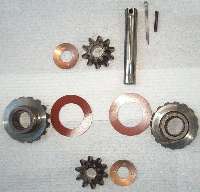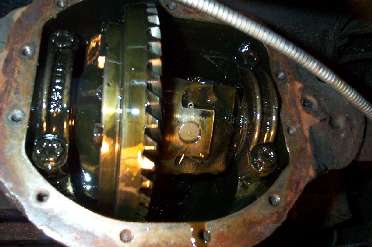Just a Simple Wrench
Saving Our Rears - by Ann & Jake Snyder
 Once, a long time ago, a friend in the club told us of a particularly unsettling catastrophic failure of a drive line component. Ordinarily, a drive line component failure means a run rod bearing, a clutch disk that came apart or a gearbox that was expected to run forever without oil. These are all bothersome for various reasons, but not of the degree to warrant a “particularly unsettling” designation. This specific failure had to do with the rear axle, and it locked up at speed. The car was an MGC (an important point) and the driver regained complete control “after both axle shafts broke”. His analysis of the incident was that the pinion pin that holds the differential pinions had moved out of position because the tension pin holding it had somehow come out. This pinion pin, whirling around at the same speed as the wheels, somewhere between 1000 and 1500 rpm, worked its way out of the differential cage (see Bentley, Plate Ha3 for the names of the parts, or look at Figure 1) and jammed in the rear axle housing. The rear wheels stopped turning, but the car was still traveling forward, front end first, in the best of circumstances. His advice to us was to put a split pin through the tension pin and to check the tension pin every year for any sign of deterioration. We thanked him, and very sincerely meant to follow his advice. But we have only an MGB, and he attributed the tension pin failure to the high torque of the MGC engine. Of course, there could only be a torque motion on the tension pin when differential action of the wheels is required, as in rounding a corner or spinning the rear wheels at a fast start, an act that is less probable for an MGB than for an MGC.
Once, a long time ago, a friend in the club told us of a particularly unsettling catastrophic failure of a drive line component. Ordinarily, a drive line component failure means a run rod bearing, a clutch disk that came apart or a gearbox that was expected to run forever without oil. These are all bothersome for various reasons, but not of the degree to warrant a “particularly unsettling” designation. This specific failure had to do with the rear axle, and it locked up at speed. The car was an MGC (an important point) and the driver regained complete control “after both axle shafts broke”. His analysis of the incident was that the pinion pin that holds the differential pinions had moved out of position because the tension pin holding it had somehow come out. This pinion pin, whirling around at the same speed as the wheels, somewhere between 1000 and 1500 rpm, worked its way out of the differential cage (see Bentley, Plate Ha3 for the names of the parts, or look at Figure 1) and jammed in the rear axle housing. The rear wheels stopped turning, but the car was still traveling forward, front end first, in the best of circumstances. His advice to us was to put a split pin through the tension pin and to check the tension pin every year for any sign of deterioration. We thanked him, and very sincerely meant to follow his advice. But we have only an MGB, and he attributed the tension pin failure to the high torque of the MGC engine. Of course, there could only be a torque motion on the tension pin when differential action of the wheels is required, as in rounding a corner or spinning the rear wheels at a fast start, an act that is less probable for an MGB than for an MGC.

The photo shows the inner pieces of the differential assembly. The pinion pin, the split pin and the tension pin are at the top. The factory did not fit the split pin. You should do it yourself.
Had this been the only time we heard of this failure, we would be less concerned about MGBs in general. But at one of the University Motors LTD technical seminars held every February near Grand Rapids, Michigan, Mr. Twist told us of a car that had been brought in with a locked rear axle caused by the pinion pin slipping out of position after the tension pin failed. The car was not a mightily powered MGC or a V-8 conversion, in which wheel-spinning is always an option. It was the common, anemic MGB, in which wheel-spinning is limited to surfaces covered with mud, ice or snow.

The split pin in place. The handbrake cable is at the upper right
Placing the split pin though the tension pin is a very minor job. It can be combined with replacing the shims on the differential wheels (the gears that slip over the inner ends of the axle shafts), replacing the hand brake cable (you are down there anyway), replacing the brake lines, or finally realizing that the differential cover should be painted occasionally because having oil in the inside does not protect it from rust from the outside. All you need to do is:
 a. Drain the gear lube a. Drain the gear lube
 b. Remove the bolts, being very careful not to twist the brake pipe b. Remove the bolts, being very careful not to twist the brake pipe
 c. Remove the differential cover c. Remove the differential cover
 d. Insert the largest split pin that will fit, bending it so it cannot fall out d. Insert the largest split pin that will fit, bending it so it cannot fall out
 e. Replace the cover after fitting a fresh gasket, and fill it with 80-90 hypoid lube. e. Replace the cover after fitting a fresh gasket, and fill it with 80-90 hypoid lube.
Do it now. We did (but only one car, so far). We are still at risk, too.
|




